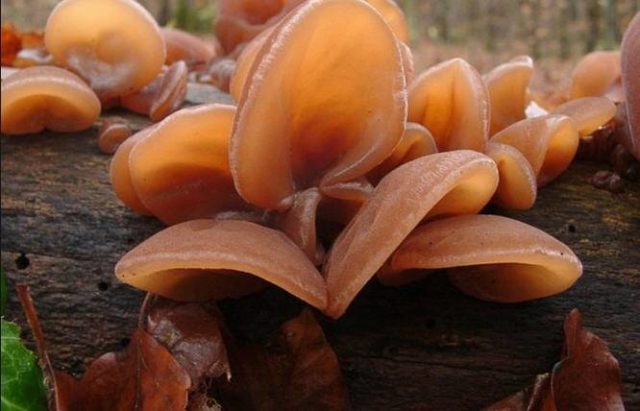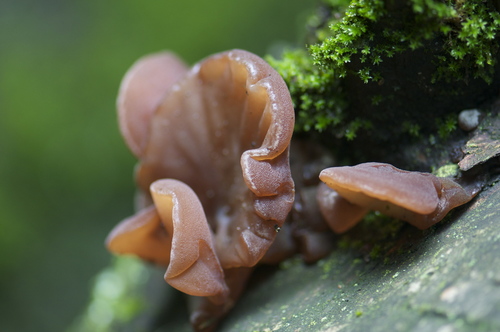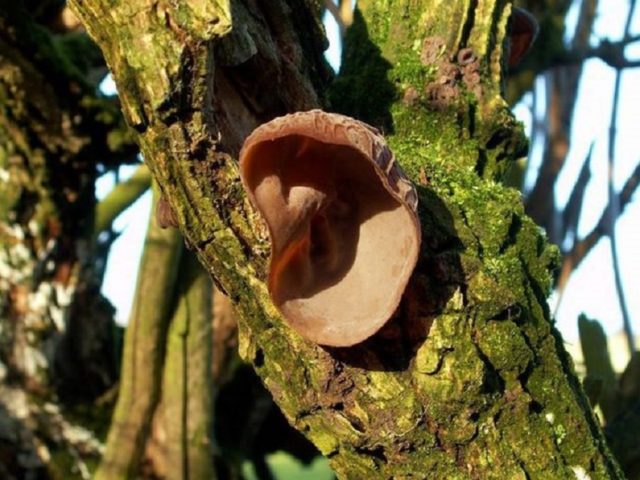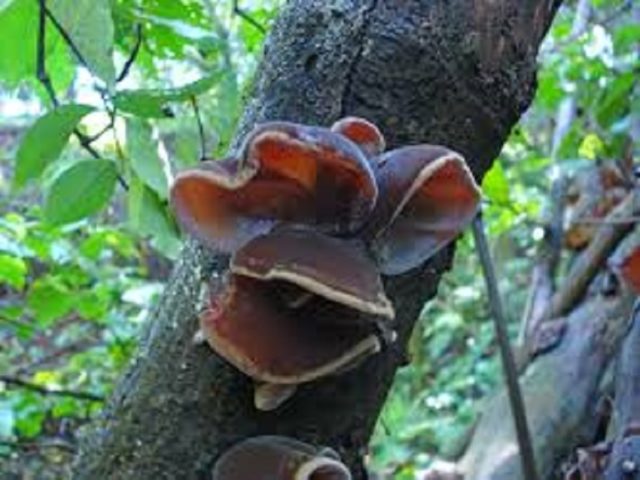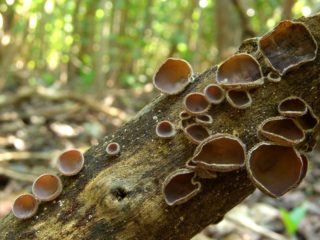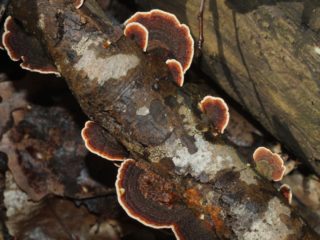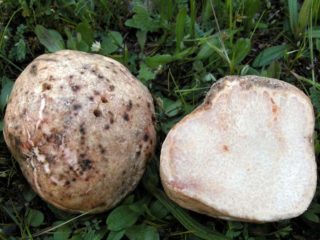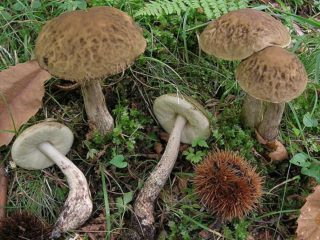Content
Auricularia auricular belongs to the Auriculariaceae family, the genus Basidiomycetes. The name of the mushroom in Latin is Auriculariaauricula-judae. In addition, there are several other names that are known to mushroom lovers. They all descended from the unusual shape of the fruiting body, similar to the human ear. If we are talking about ohaimuer, kikurage, devil's ear, dog's ear or Judah's ear, then this is the same mushroom. Translated from Chinese "heimuer" sounds like a black tree ear, from Japanese "kikurage" - woody jellyfish.
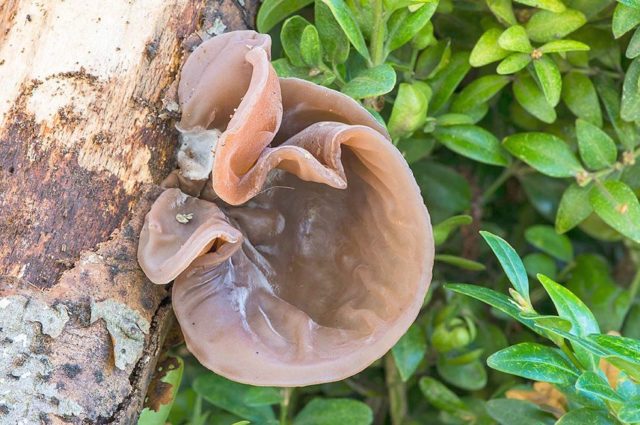
Due to its original appearance, auricular auricular cannot be confused with other mushrooms.
Where does auricular auricular grow
The fungus belongs to saprotrophs, it is considered a parasite. Found on dead or weakened trees. He prefers hardwood, among them elderberry, maple, oak, alder. Placed at the base of the trunk and on the branches.
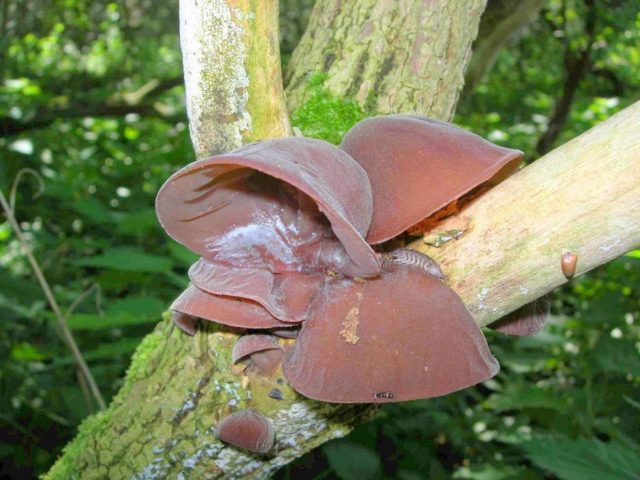
The fungus grows on diseased or weakened wood, it is very noticeable on it
Loves a temperate climate, high humidity and warmth. The peak fruiting of auricularia lasts from mid-July to the end of November, although harvesting of fruiting bodies is possible throughout the year. The easiest way to harvest a good harvest is after a rainy season.
Grows in groups and single specimens. On the territory of the Russian Federation, it is most often found in the Caucasus.
What does auricular auricular look like
The species has a very unusual shape of the fruiting body:
- Hat. The appearance of the cap resembles an auricle or console with a diameter of about 12 cm. There may be small specimens with a diameter of about 4-6 cm. It is attached to the trunk sideways. The color is different. Color variability from brownish red to black. The hue also changes with the weather. The outer surface of the cap is rough and finely fleecy, while the inner surface is smooth. The hat is velvety to the touch.
- The flesh of auricularia is very thin, but dense, in some places almost transparent. It is elastic in structure, but gelatinous. When the mushroom dries, it decreases in size.
- The leg is very short, tightly pressed against the wood. Therefore, it does not have a pronounced form.
- The spore powder is white, the spores are elliptical.
A mushroom found in the forest always fully matches the description.
Is it possible to eat auricular auricular
The mushroom belongs to the conditionally edible group. In dishes, the pulp of auricularia has a peculiar structure. It is crispy, cartilage-like in consistency, dense.
Mushroom taste
Fruit bodies are in the second category of taste parameters, in other words, average. The mushroom is more appreciated in the East - in China, Japan. The traditional cuisine of these countries includes a huge number of dishes with auricularia. The mushroom is prepared in various combinations, using the usual culinary treatments, and is also used raw for salads.
Benefits and harm to the body
The nutritional value of auricularia is very high.The pulp contains:
- protein;
- carbohydrates;
- macro- and microelements;
- a whole range of vitamins.
Auricularia is rich in vitamin B, calcium, silicon, magnesium.
Due to this composition, the mushroom is used not only in cooking, but also in medicine. There is historical evidence of the use of fruit body infusion for the treatment of the eyes and throat. There are many recipes with haymuerne only in folk medicine, but also in traditional medicine. They work in case of poisoning as enterosorbents, restore the vitality of the body after radiation and chemotherapy. Very good results were recorded in the presence of allergic manifestations, increased body weight, and a decrease in the rate of metabolic processes. There is information about the anti-inflammatory, hemostatic, analgesic effect of the fungus.
However, like any remedy, auricularia has contraindications for medicinal use. These include:
- The period of pregnancy and feeding of the baby.
- Children under 10 years of age.
- Individual intolerance.
False doubles
No such fruiting bodies are known in the inedible variety. Also, representatives are not described with which the Judas ear could be confused. Among similar mushrooms, it should be noted:
- Auricularia thick-haired (Auricularia polytricha). More widespread. It settles on trunks and branches of deciduous trees in tropical forests. The consistency of the fruiting body is pleasant, but they are tasteless. The cap is more hairy, colored from off-white to gray-brown.
- Horny auricularia (Auricularia cornea). Differs from ear-shaped in shorter hair length and olive-colored coloration.
Both mushrooms are classified as edible.
Collection rules
On the territory of the Russian Federation, auricularia is collected in the winter. It is clearly visible on trunks and branches without foliage. The rules for collecting mu er do not differ from the traditional memo for those who like "quiet hunting":
- There are many types of woody mushrooms, some of which are inedible. Before going into the forest, you must familiarize yourself with the description and photo of the auricularia, so as not to confuse the species.
- You should not collect the fruit bodies in bags, it is better to carefully put them in a basket.
- You can take dry specimens, which, after soaking, will acquire their original appearance and structure.
- The best time for a "quiet hunt" is morning.
Adhering to simple recommendations, you can stock up on useful mushrooms even in winter.

A characteristic feature of the species to grow in groups allows you to collect a large basket in a short time
Use
Chinese and Japanese chefs prepare a huge number of dishes from the Heimu era. Auricularia can be dried, boiled, eaten raw. The easiest way to buy the mushroom is dried, then soak it for 1 hour and start cooking.
Very tasty sauces are made from pre-soaked mushrooms, soups, main courses, snacks, salads are prepared. Stewed mushrooms or steamed with vegetables taste good. Auricularia goes well with fish, meat, seafood, noodles. Due to its low calorie content, Judah's ear is used in dietary nutrition.
Usually, non-spicy dishes are prepared so as not to interrupt the taste of the main component.
For storage, the mushrooms are dried whole. Auricularia at the same time changes color, becomes black.
When the fruit bodies are soaked, they are saturated with moisture and take on their usual shape, taste, texture and color.

Before cooking, the auricularia looks like a freshly plucked mushroom
Conclusion
Auricularia auricular is an amazing mushroom with an unusual shape. The nutritional composition and low calorie content make it very attractive for culinary and amateur mushroom pickers.
